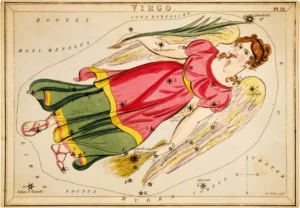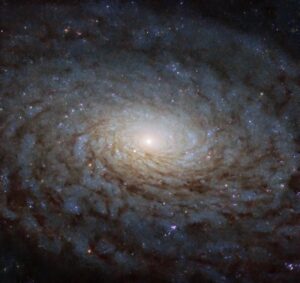Look for the Constellation Virgo the Virgin in May and Learn Why She Symbolizes Fertility and the Changing of the Seasons
 Symbolism: Virgo the Virgin represented as a maiden holding a sheaf of wheat or ear of corn, symbolizing fertility and harvest. Learn more about the night sky at the Star and Space Blog.
Symbolism: Virgo the Virgin represented as a maiden holding a sheaf of wheat or ear of corn, symbolizing fertility and harvest. Learn more about the night sky at the Star and Space Blog.
Mythology: Overall, the stories and legends associated with the constellation Virgo often focus on themes of fertility, agriculture, and the changing of the seasons:
- According to Greek mythology, the constellation Virgo represents the goddess Demeter, who was the goddess of agriculture, harvest, and fertility. Demeter was said to be the mother of Persephone, who was kidnapped by Hades and taken to the underworld. In her grief, Demeter neglected her duties as goddess of agriculture, causing a great famine on Earth. Eventually, Persephone was allowed to return to the surface for part of the year, which symbolized the changing of the seasons and the cycles of life and death.
- In Babylonian mythology, the constellation Virgo was associated with the goddess Shala, who was the goddess of grain and fertility. She was often depicted holding sheaves of wheat or barley.
- In Hindu mythology, the constellation Virgo was associated with the goddess Kanya, who was the daughter of the king of the gods. She was known for her beauty and her devotion to the gods.
- In ancient Egypt, the constellation was associated with the goddess Isis, who was the goddess of motherhood and fertility. Isis was often depicted holding an ear of corn or a sheaf of wheat, which represented the bounty of the harvest.
When is it visible? Virgo is a popular constellation among stargazers, and it can be easily seen in the night sky during the spring and summer months.
How to find it? The bright star Spica makes it easy to locate Virgo, as it can be found by following the curve of the Big Dipper to Arcturus in Boötes and continuing from there in the same curve.It may be helpful to use a star chart like the ones that you receive from Name a Star, when you dedicate a star to someone.
History and Science: Virgo is one of the most ancient constellations, with records of its existence dating back to ancient Babylonian times.
One of the most distinctive features of Virgo is the star Spica, which is the brightest star in the constellation. Spica is actually a binary star system, meaning that it is made up of two stars that orbit around each other. Spica is also one of the nearest massive stars to Earth, located just 260 light-years away. Virgo is home to many galaxies, including the Virgo Cluster, which is a group of more than 1,000 galaxies that are located approximately 60 million light-years away from Earth. The Virgo Cluster is one of the closest galaxy clusters to Earth, and it contains several well-known galaxies, including Messier 87 and Messier 49.

